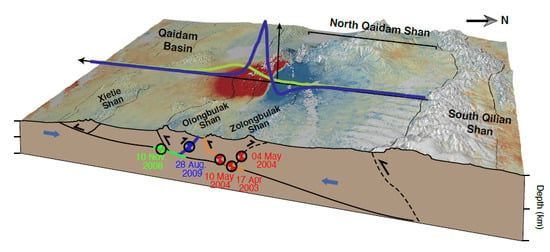Illuminating the Spatio-Temporal Evolution of the 2008–2009 Qaidam Earthquake Sequence with the Joint Use of Insar Time Series and Teleseismic Data
Abstract
1. Introduction
2. Materials and Methods
2.1. Seismic Back-Projection Source Imaging
2.1.1. Data and Station Clustering
2.1.2. Muti-Array Back-Projection Method
2.2. Kinematic Fault Inversion
2.2.1. Teleseismic Data
2.2.2. Insar Time Series (Ts) Data
2.2.3. Fault Inference Method
2.2.4. Fault Inference of the 2008 Earthquake
2.2.5. Fault Inference of the 2009 Earthquake
3. Results
3.1. Back-Projection Imaging of the 2008–2009 Sequence
3.2. 2008 Fault Characteristics Estimations
3.3. 2009 Fault Characteristics Estimations
4. Discussion
4.1. Benefits of InSAR Time Series (TS) for Fault Inference
4.2. Back-Projection Imaging for Moderate-Size Earthquakes
4.3. The 2008–2009 Qaidam Earthquake Sequence
5. Conclusions
Supplementary Materials
Author Contributions
Funding
Acknowledgments
Conflicts of Interest
References
- Duputel, Z.; Agram, P.S.; Simons, M.; Minson, S.E.; Beck, J.L. Accounting for prediction uncertainty when inferring subsurface fault slip. Geophys. J. Int. 2014, 197, 464–482. [Google Scholar] [CrossRef]
- Ragon, T.; Sladen, A.; Simons, M. Accounting for uncertain fault geometry in earthquake source inversions—I: Theory and simplified application. Geophys. J. Int. 2018, 214, 1174–1190. [Google Scholar] [CrossRef]
- Langer, L.; Ragon, T.; Sladen, A.; Tromp, J. Impact of topography on earthquake static slip inversions. Tectonophysics 2020, 228566. [Google Scholar] [CrossRef]
- Steinberg, A.; Sudhaus, H.; Heimann, S.; Krüger, F. Sensitivity of InSAR and teleseismic observations to earthquake rupture segmentation. Geophys. J. Int. 2020, 223, 875–907. [Google Scholar] [CrossRef]
- Mai, P.M.; Schorlemmer, D.; Page, M.; Ampuero, J.P.; Asano, K.; Causse, M.; Custodio, S.; Fan, W.; Festa, G.; Galis, M.; et al. The earthquake-source inversion validation (SIV) project. Seismol. Res. Lett. 2016, 87, 690–708. [Google Scholar] [CrossRef]
- Bletery, Q.; Sladen, A.; Delouis, B.; Vallée, M.; Nocquet, J.M.; Rolland, L.; Jiang, J. A detailed source model for the Mw9. 0 Tohoku-Oki earthquake reconciling geodesy, seismology, and tsunami records. J. Geophys. Res. Solid Earth 2014, 119, 7636–7653. [Google Scholar] [CrossRef]
- Marchandon, M.; Vergnolle, M.; Sudhaus, H.; Cavalié, O. Fault Geometry and Slip Distribution at Depth of the 1997 Mw 7.2 Zirkuh Earthquake: Contribution of Near-Field Displacement Data. J. Geophys. Res. Solid Earth 2018, 123, 1904–1924. [Google Scholar] [CrossRef]
- Akoğlu, A.M.; Jónsson, S.; Wang, T.; Çakır, Z.; Dogan, U.; Ergintav, S.; Osmanoğlu, B.; Feng, G.; Zabcı, C.; Özdemir, A.; et al. Evidence for tear faulting from new constraints of the 23 October 2011 Mw 7.1 van, Turkey, earthquake based on InSAR, GPS, coastal uplift, and field observationsevidence for tear faulting from new constraints of the 2011 van, Turkey, earthquake. Bull. Seismol. Soc. Am. 2018, 108, 1929–1946. [Google Scholar] [CrossRef]
- Gombert, B.; Duputel, Z.; Jolivet, R.; Doubre, C.; Rivera, L.; Simons, M. Revisiting the 1992 Landers earthquake: A Bayesian exploration of co-seismic slip and off-fault damage. Geophys. J. Int. 2018, 212, 839–852. [Google Scholar] [CrossRef]
- Weston, J.; Ferreira, A.; Funning, G. Joint earthquake source inversions using seismo-geodesy and 3-D earth models. Geophys. J. Int. 2014, 198, 671–696. [Google Scholar] [CrossRef]
- Huang, M.H.; Tung, H.; Fielding, E.J.; Huang, H.H.; Liang, C.; Huang, C.; Hu, J.C. Multiple fault slip triggered above the 2016 Mw 6.4 MeiNong earthquake in Taiwan. Geophys. Res. Lett. 2016, 43, 7459–7467. [Google Scholar] [CrossRef]
- Frietsch, M.; Ferreira, A.; Funning, G.; Weston, J. Multiple fault modelling combining seismic and geodetic data: The importance of simultaneous subevent inversions. Geophys. J. Int. 2019, 218, 958–976. [Google Scholar] [CrossRef]
- Vasyura-Bathke, H.; Dettmer, J.; Steinberg, A.; Heimann, S.; Isken, M.P.; Zielke, O.; Mai, P.M.; Sudhaus, H.; Jónsson, S. The Bayesian Earthquake Analysis Tool. Seismol. Res. Lett. 2020, 91, 1003–1018. [Google Scholar] [CrossRef]
- Lohman, R.B.; Simons, M. Some thoughts on the use of InSAR data to constrain models of surface deformation: Noise structure and data downsampling. Geochem. Geophys. Geosyst. 2005, 6. [Google Scholar] [CrossRef]
- Sudhaus, H.; Sigurjón, J. Improved source modelling through combined use of InSAR and GPS under consideration of correlated data errors: Application to the June 2000 Kleifarvatn earthquake, Iceland. Geophys. J. Int. 2009, 176, 389–404. [Google Scholar] [CrossRef]
- Cesca, S.; Letort, J.; Razafindrakoto, H.N.; Heimann, S.; Rivalta, E.; Isken, M.P.; Nikkhoo, M.; Passarelli, L.; Petersen, G.M.; Cotton, F.; et al. Drainage of a deep magma reservoir near Mayotte inferred from seismicity and deformation. Nat. Geosci. 2020, 13, 87–93. [Google Scholar] [CrossRef]
- Minson, S.; Simons, M.; Beck, J. Bayesian inversion for finite fault earthquake source models I. Theory and algorithm. Geophys. J. Int. 2013, 194, 1701–1726. [Google Scholar] [CrossRef]
- Minson, S.; Simons, M.; Beck, J.; Ortega, F.; Jiang, J.; Owen, S.; Moore, A.; Inbal, A.; Sladen, A. Bayesian inversion for finite fault earthquake source models–II: The 2011 great Tohoku-oki, Japan earthquake. Geophys. J. Int. 2014, 198, 922–940. [Google Scholar] [CrossRef]
- Daout, S.; Barbot, S.; Peltzer, G.; Doin, M.P.; Liu, Z.; Jolivet, R. Constraining the Kinematics of Metropolitan Los Angeles Faults with a Slip-Partitioning Model. Geophys. Res. Lett. 2016, 43, 11–192. [Google Scholar] [CrossRef]
- Hong, S.; Zhou, X.; Zhang, K.; Meng, G.; Dong, Y.; Su, X.; Zhang, L.; Li, S.; Ding, K. Source model and stress disturbance of the 2017 Jiuzhaigou Mw 6.5 earthquake constrained by InSAR and GPS measurements. Remote Sens. 2018, 10, 1400. [Google Scholar] [CrossRef]
- Wright, T.J.; Parsons, B.E.; Lu, Z. Toward mapping surface deformation in three dimensions using InSAR. Geophys. Res. Lett. 2004, 31. [Google Scholar] [CrossRef]
- Lasserre, C.; Peltzer, G.; Crampé, F.; Klinger, Y.; Van der Woerd, J.; Tapponnier, P. Coseismic deformation of the 2001 Mw = 7.8 Kokoxili earthquake in Tibet, measured by synthetic aperture radar interferometry. J. Geophys. Res. 2005, 110. [Google Scholar] [CrossRef]
- Sudhaus, H.; Jónsson, S. Source model for the 1997 Zirkuh earthquake (MW = 7.2) in Iran derived from JERS and ERS InSAR observations. Geophys. J. Int. 2011, 185, 676–692. [Google Scholar] [CrossRef]
- Elliott, J.; Jolivet, R.; González, P.; Avouac, J.P.; Hollingsworth, J.; Searle, M.; Stevens, V. Himalayan megathrust geometry and relation to topography revealed by the Gorkha earthquake. Nat. Geosci. 2016, 9, 174–180. [Google Scholar] [CrossRef]
- Mackenzie, D.; Elliott, J.; Altunel, E.; Walker, R.; Kurban, Y.; Schwenninger, J.L.; Parsons, B. Seismotectonics and rupture process of the Mw 7.1 2011 Van reverse-faulting earthquake, eastern Turkey, and implications for hazard in regions of distributed shortening. Geophys. J. Int. 2016, 206, 501–524. [Google Scholar] [CrossRef]
- Ganas, A.; Kourkouli, P.; Briole, P.; Moshou, A.; Elias, P.; Parcharidis, I. Coseismic displacements from moderate-size earthquakes mapped by Sentinel-1 differential interferometry: The case of February 2017 Gulpinar earthquake sequence (Biga Peninsula, Turkey). Remote Sens. 2018, 10, 1089. [Google Scholar] [CrossRef]
- Hanssen, R.F. Radar Interferometry: Data Interpretation and Error Analysis; Springer Science & Business Media: Berlin/Heidelberg, Germany, 2001; Volume 2. [Google Scholar]
- Doin, M.P.; Lasserre, C.; Peltzer, G.; Cavalié, O.; Doubre, C. Corrections of stratified tropospheric delays in SAR interferometriy: Validation with global atmospheric models. J. Appl. Geophys. 2009, 69, 35–50. [Google Scholar] [CrossRef]
- Gomba, G.; Parizzi, A.; De Zan, F.; Eineder, M.; Bamler, R. Toward operational compensation of ionospheric effects in SAR interferograms: The split-spectrum method. IEEE Trans. Geosci. Remote Sens. 2015, 54, 1446–1461. [Google Scholar] [CrossRef]
- Floyd, M.A.; Walters, R.J.; Elliott, J.R.; Funning, G.J.; Svarc, J.L.; Murray, J.R.; Hooper, A.J.; Larsen, Y.; Marinkovic, P.; Bürgmann, R.; et al. Spatial variations in fault friction related to lithology from rupture and afterslip of the 2014 South Napa, California, earthquake. Geophys. Res. Lett. 2016, 43, 6808–6816. [Google Scholar] [CrossRef]
- Ragon, T.; Sladen, A.; Bletery, Q.; Vergnolle, M.; Cavalié, O.; Avallone, A.; Balestra, J.; Delouis, B. Joint Inversion of Coseismic and Early Postseismic Slip to Optimize the Information Content in Geodetic Data: Application to the 2009 M w 6.3 L’Aquila Earthquake, Central Italy. J. Geophys. Res. Solid Earth 2019, 124, 10522–10543. [Google Scholar] [CrossRef]
- Massonnet, D.; Rossi, M.; Carmona, C.; Adragna, F.; Peltzer, G.; Feigl, K.; Rabaute, T. The displacement field of the Landers earthquake mapped by radar interferometry. Nature 1993, 364, 138–142. [Google Scholar] [CrossRef]
- Berardino, P.; Fornaro, G.; Lanari, R.; Sansosti, E. A new algorithm for surface deformation monitoring based on small baseline differential SAR interferograms. IEEE Trans. Geosci. Remote Sens. 2002, 40, 2375–2383. [Google Scholar] [CrossRef]
- Hooper, A. A multi-temporal InSAR method incorporating both persistent scatterer and small baseline approaches. Geophys. Res. Lett. 2008, 35. [Google Scholar] [CrossRef]
- Doin, M.P.; Twardzik, C.; Ducret, G.; Lasserre, C.; Guillaso, S.; Jianbao, S. InSAR measurement of the deformation around Siling Co Lake: Inferences on the lower crust viscosity in central Tibet. J. Geophys. Res. Solid Earth 2015, 120, 5290–5310. [Google Scholar] [CrossRef]
- Jolivet, R.; Grandin, R.; Lasserre, C.; Doin, M.P.; Peltzer, G. Systematic InSAR tropospheric phase delay corrections from global meteorological reanalysis data. Geophys. Res. Lett. 2011, 38. [Google Scholar] [CrossRef]
- Daout, S.; Dini, B.; Haeberli, W.; Doin, M.P.; Parsons, B. Ice loss in the Northeastern Tibetan Plateau permafrost as seen by 16 yr of ESA SAR missions. Earth Planet. Sci. Lett. 2020, 545, 116404. [Google Scholar] [CrossRef]
- Cavalié, O.; Doin, M.P.; Lasserre, C.; Briole, P. Ground motion measurement in the Lake Mead area, Nevada, by differential synthetic aperture radar interferometry time series analysis: Probing the lithosphere rheological structure. J. Geophys. Res. 2007, 112. [Google Scholar] [CrossRef]
- Lin, Y.n.N.; Simons, M.; Hetland, E.A.; Muse, P.; DiCaprio, C. A multiscale approach to estimating topographically correlated propagation delays in radar interferograms. Geochem. Geophys. Geosyst. 2010, 11. [Google Scholar] [CrossRef]
- Isken, M.; Sudhaus, H.; Heimann, S.; Steinberg, A.; Daout, S.; Vasyura-Bathke, H. Kite—Software for Rapid Earthquake Source Optimisation from InSAR Surface Displacement. GFZ Data Serv. 2017. [Google Scholar] [CrossRef]
- Yu, C.; Li, Z.; Penna, N.T.; Crippa, P. Generic atmospheric correction model for Interferometric Synthetic Aperture Radar observations. J. Geophys. Res. Solid Earth 2018, 123, 9202–9222. [Google Scholar] [CrossRef]
- Dini, B.; Daout, S.; Manconi, A.; Loew, S. Classification of slope processes based on multitemporal DInSAR analyses in the Himalaya of NW Bhutan. Remote Sens. Environ. 2019, 233, 111408. [Google Scholar] [CrossRef]
- Wimpenny, S.; Copley, A.; Ingleby, T. Fault mechanics and post-seismic deformation at Bam, SE Iran. Geophys. J. Int. 2017, 209, 1018–1035. [Google Scholar] [CrossRef]
- Barnhart, W.D.; Brengman, C.M.; Li, S.; Peterson, K.E. Ramp-flat basement structures of the Zagros Mountains inferred from co-seismic slip and afterslip of the 2017 Mw 7.3 Darbandikhan, Iran/Iraq earthquake. Earth Planet. Sci. Lett. 2018, 496, 96–107. [Google Scholar] [CrossRef]
- Daout, S.; Sudhaus, H.; Kausch, T.; Steinberg, A.; Dini, B. Interseismic and postseismic shallow creep of the North Qaidam Thrust faults detected with a multitemporal InSAR analysis. J. Geophys. Res. Solid Earth 2019, 124, 7259–7279. [Google Scholar] [CrossRef]
- Elliott, J.; Parsons, B.; Jackson, J.; Shan, X.; Sloan, R.; Walker, R. Depth segmentation of the seismogenic continental crust: The 2008 and 2009 Qaidam earthquakes. Geophys. Res. Lett. 2011, 38. [Google Scholar] [CrossRef]
- Guihua, C.; Xiwei, X.; Ailan, Z.; Xiaoqing, Z.; Renmao, Y.; Klinger, Y.; Nocquet, J.M. Seismotectonics of the 2008 and 2009 Qaidam earthquakes and its implication for regional tectonics. Acta Geol. Sin. Engl. Ed. 2013, 87, 618–628. [Google Scholar] [CrossRef]
- Feng, W. Modelling Co-and Post-Seismic Displacements Revealed by InSAR, and Their Implications for Fault Behaviour. Ph.D. Thesis, University of Glasgow, Glasgow, UK, 2015. [Google Scholar]
- Liu, Y.; Xu, C.; Wen, Y.; Li, Z. Post-seismic deformation from the 2009 Mw 6.3 Dachaidan earthquake in the northern Qaidam Basin detected by small baseline subset InSAR technique. Sensors 2016, 16, 206. [Google Scholar] [CrossRef]
- Liu, Y.; Xu, C.; Li, Z.; Wen, Y.; Chen, J.; Li, Z. Time-dependent afterslip of the 2009 mw 6.3 dachaidan earthquake (China) and viscosity beneath the qaidam basin inferred from postseismic deformation observations. Remote Sens. 2016, 8, 649. [Google Scholar] [CrossRef]
- Daout, S.; Doin, M.P.; Peltzer, G.; Socquet, A.; Lasserre, C. Large scale InSAR monitoring of permafrost freeze-thaw cycles on the Tibetan Plateau. Geophys. Res. Lett. 2017. [Google Scholar] [CrossRef]
- Burchfiel, B.; Quidong, D.; Molnar, P.; Royden, L.; Yipeng, W.; Peizhen, Z.; Weiqi, Z. Intracrustal detachment within zones of continental deformation. Geology 1989, 17, 748–752. [Google Scholar] [CrossRef]
- Métivier, F.; Gaudemer, Y.; Tapponnier, P.; Meyer, B. Northeastward growth of the Tibet Plateau deduced from balanced reconstruction of two depositional areas: The Qaidam and Hexi Corridor Basins, China. Tectonics 1998, 17, 823–842. [Google Scholar] [CrossRef]
- Meyer, B.; Tapponnier, P.; Bourjot, L.; Metivier, F.; Gaudemer, Y.; Peltzer, G.; Shunmin, G.; Zhitai, C. Crustal thickening in Gausu-Qinghai, lithospheric mantle subduction, and oblique, strike-slip controlled growth of the Tibet Plateau. Geophy. J. Int. 1998, 135, 1–47. [Google Scholar] [CrossRef]
- Tapponnier, P.; Zhiqin, X.; Roger, F.; Meyer, B.; Arnaud, N.; Wittlinger, G.; Jingsui, Y. Oblique Stepwise Rise and Growth of the Tibet Plateau. Science 2001, 294, 1671–1677. [Google Scholar] [CrossRef] [PubMed]
- Dupont-Nivet, G.; Horton, B.; Butler, R.F.; Wang, J.; Zhou, J.; Waanders, G. Paleogene clockwise tectonic rotation of the Xining-Lanzhou region, northeastern Tibetan Plateau. J. Geophys. Res. Solid Earth 2004, 109. [Google Scholar] [CrossRef]
- Yin, A.; Dang, Y.Q.; Wang, L.C.; Jiang, W.M.; Zhou, S.P.; Chen, X.H.; Gehrels, G.E.; McRivette, M.W. Cenozoic tectonic evolution of Qaidam Basin and its surrounding regions (Part 1): The southern Qilian Shan-Nan Shan thrust belt and northern Qaidam Basin. Geol. Soc. Am. Bull. 2008, 120, 813–846. [Google Scholar] [CrossRef]
- Bush, M.A.; Saylor, J.E.; Horton, B.K.; Nie, J. Growth of the Qaidam Basin during Cenozoic exhumation in the northern Tibetan Plateau: Inferences from depositional patterns and multiproxy detrital provenance signatures. Lithosphere 2016, 8, 58–82. [Google Scholar] [CrossRef]
- Yin, A.; Harrison, T.M. Geologic evolution of the Himalayan-Tibetan orogen. Annu. Rev. Earth Planet. Sci. 2000, 28, 211–280. [Google Scholar] [CrossRef]
- Yin, A.; Dang, Y.Q.; Zhang, M.; Chen, X.H.; McRivette, M.W. Cenozoic tectonic evolution of the Qaidam Basin and its surrounding regions (Part 3): Structural geology, sedimentation, and regional tectonic reconstruction. Geol. Soc. Am. Bull. 2008, 120, 847–876. [Google Scholar] [CrossRef]
- England, P.C.; Houseman, G. The mechanics of the Tibetan Plateau. Phil. Trans. R. Soc. Lond. A 1988, 326, 301–320. [Google Scholar]
- Royden, L.H.; Burchfiel, B.C.; King, R.W.; Wang, E.; Chen, Z.; Shen, F.; Liu, Y. Surface deformation and lower crustal flow in eastern Tibet. Science 1997, 276, 788–790. [Google Scholar] [CrossRef]
- Clark, M.K.; Royden, L.H. Topographic ooze: Building the eastern margin of Tibet by lower crustal flow. Geology 2000, 28, 703–706. [Google Scholar] [CrossRef]
- Ekström, G.; Nettles, M.; Dziewoński, A. The global CMT project 2004–2010: Centroid-moment tensors for 13,017 earthquakes. Phys. Earth Planet. Inter. 2012, 200, 1–9. [Google Scholar] [CrossRef]
- Liu, Y.; Xu, C.; Wen, Y.; Fok, H.S. A new perspective on fault geometry and slip distribution of the 2009 Dachaidan Mw 6.3 earthquake from InSAR observations. Sensors 2015, 15, 16786–16803. [Google Scholar] [CrossRef] [PubMed]
- Krüger, F.; Ohrnberger, M. Tracking the rupture of the Mw = 9.3 Sumatra earthquake over 1150 km at teleseismic distance. Nature 2005, 435, 937. [Google Scholar] [CrossRef]
- Kiser, E.; Ishii, M. Back-projection imaging of earthquakes. Annu. Rev. Earth Planet. Sci. 2017, 45, 271–299. [Google Scholar] [CrossRef]
- Ruppert, N.A.; Rollins, C.; Zhang, A.; Meng, L.; Holtkamp, S.G.; West, M.E.; Freymueller, J.T. Complex faulting and triggered rupture during the 2018 MW 7.9 offshore Kodiak, Alaska, earthquake. Geophys. Res. Lett. 2018, 45, 7533–7541. [Google Scholar] [CrossRef]
- Hicks, S.P.; Okuwaki, R.; Steinberg, A.; Rychert, C.A.; Harmon, N.; Abercrombie, R.E.; Bogiatzis, P.; Schlaphorst, D.; Zahradnik, J.; Kendall, J.M.; et al. Back-propagating supershear rupture in the 2016 M w 7.1 Romanche transform fault earthquake. Nat. Geosci. 2020, 13, 647–653. [Google Scholar] [CrossRef]
- Hanka, W.; Kind, R. The GEOFON program. Ann. Geophys. 1994, 37. [Google Scholar] [CrossRef]
- Trabant, C.; Hutko, A.R.; Bahavar, M.; Karstens, R.; Ahern, T.; Aster, R. Data products at the IRIS DMC: Stepping stones for research and other applications. Seismol. Res. Lett. 2012, 83, 846–854. [Google Scholar] [CrossRef]
- Rössler, D.; Krueger, F.; Ohrnberger, M.; Ehlert, L. Rapid characterisation of large earthquakes by multiple seismic broadband arrays. Nat. Hazards Earth Syst. Sci. 2010, 10, 923–932. [Google Scholar] [CrossRef][Green Version]
- Madariaga, R. High-frequency radiation from crack (stress drop) models of earthquake faulting. Geophys. J. R. Astron. Soc. 1977, 51, 625–651. [Google Scholar] [CrossRef]
- Ide, S. Estimation of radiated energy of finite-source earthquake models. Bull. Seismol. Soc. Am. 2002, 92, 2994–3005. [Google Scholar] [CrossRef]
- Schimmel, M.; Paulssen, H. Noise reduction and detection of weak, coherent signals through phase-weighted stacks. Geophys. J. Int. 1997, 130, 497–505. [Google Scholar] [CrossRef]
- Palo, M.; Tilmann, F.; Krueger, F.; Ehlert, L.; Lange, D. High-frequency seismic radiation from Maule earthquake (M w 8.8, 2010 February 27) inferred from high-resolution backprojection analysis. Geophys. J. Int. 2014, 199, 1058–1077. [Google Scholar] [CrossRef]
- Ishii, M.; Shearer, P.M.; Houston, H.; Vidale, J.E. Teleseismic P wave imaging of the 26 December 2004 Sumatra-Andaman and 28 March 2005 Sumatra earthquake ruptures using the Hi-net array. J. Geophys. Res. Solid Earth 2007, 112. [Google Scholar] [CrossRef]
- Meng, L.; Zhang, A.; Yagi, Y. Improving back projection imaging with a novel physics-based aftershock calibration approach: A case study of the 2015 Gorkha earthquake. Geophys. Res. Lett. 2016, 43, 628–636. [Google Scholar] [CrossRef]
- Fan, W.; Shearer, P.M. Investigation of backprojection uncertainties with M6 earthquakes. J. Geophys. Res. Solid Earth 2017, 122, 7966–7986. [Google Scholar] [CrossRef]
- Efron, B. The Jackknife, the Bootstrap and Other Resampling Plans; SIAM: Philadelphia, PA, USA, 1982. [Google Scholar]
- Heimann, S.; Isken, M.; Kühn, D.; Sudhaus, H.; Steinberg, A.; Vasyura-Bathke, H.; Daout, S.; Cesca, S.; Dahm, T. Grond—A probabilistic earthquake source inversion framework. GFZ Data Serv. 2018. [Google Scholar] [CrossRef]
- Kühn, D.; Heimann, S.; Isken, M.P.; Ruigrok, E.; Dost, B. Probabilistic Moment Tensor Inversion for Hydrocarbon-Induced Seismicity in the Groningen Gas Field, The Netherlands. Bull. Seismol. Soc. Am. 2020. [Google Scholar] [CrossRef]
- López-Quiroz, P.; Doin, M.P.; Tupin, F.; Briole, P.; Nicolas, J.M. Time series analysis of Mexico City subsidence constrained by radar interferometry. J. Appl. Geophys. 2009, 69, 1–15. [Google Scholar] [CrossRef]
- Peltzer, G.; Rosen, P.; Rogez, F.; Hudnut, K. Poroelastic rebound along the Landers 1992 earthquake surface rupture. J. Geophys. Res. Solid Earth 1998, 103, 30131–30145. [Google Scholar] [CrossRef]
- Rollins, C.; Barbot, S.; Avouac, J.P. Postseismic Deformation Following the 2010 M=7.2 El Mayor-Cucapah Earthquake: Observations, Kinematic Inversions, and Dynamic Models. Pure Appl. Geophys. 2015, 172, 1305–1358. [Google Scholar] [CrossRef]
- Zhao, D.; Qu, C.; Shan, X.; Bürgmann, R.; Gong, W.; Zhang, G. Spatiotemporal Evolution of Postseismic Deformation Following the 2001 Mw7. 8 Kokoxili, China, Earthquake from 7 Years of Insar Observations. Remote Sens. 2018, 10, 1988. [Google Scholar] [CrossRef]
- Marone, C. Laboratory-derived friction laws and their application to seismic faulting. Annu. Rev. Earth Planet. Sci. 1998, 26, 643–696. [Google Scholar] [CrossRef]
- Perfettini, H.; Avouac, J.P. Postseismic relaxation driven by brittle creep: A possible mechanism to reconcile geodetic measurements and the decay rate of aftershocks, application to the Chi-Chi earthquake, Taiwan. J. Geophys. Res. Solid Earth 2004, 109. [Google Scholar] [CrossRef]
- Wang, R.; Lorenzo-Martín, F.; Roth, F. PSGRN/PSCMP: A new code for calculating co-and post-seismic deformation, geoid and gravity changes based on the viscoelastic-gravitational dislocation theory. Comput. Geosci. 2006, 32, 527–541. [Google Scholar] [CrossRef]
- Wang, R. A Simple Orthonormalization Method for Stable and Efficient Computation of Green’s Functions. Bull. Seismol. Soc. Am. 1999, 89, 733–741. [Google Scholar]
- Kennett, B.; Engdahl, E. Traveltimes for global earthquake location and phase identification. Geophys. J. Int. 1991, 105, 429–465. [Google Scholar] [CrossRef]
- Mooney, W.D.; Laske, G.; Masters, T.G. CRUST 5.1: A global crustal model at 5× 5. J. Geophys. Res. Solid Earth 1998, 103, 727–747. [Google Scholar] [CrossRef]
- Liang, S.; Gan, W.; Shen, C.; Xiao, G.; Liu, J.; Chen, W.; Ding, X.; Zhou, D. Three-dimensional velocity field of present-day crustal motion of the Tibetan Plateau derived from GPS measurements. J. Geophys. Res. 2013, 118, 5722–5732. [Google Scholar] [CrossRef]
- Wang, W.; Qiao, X.; Yang, S.; Wang, D. Present-day velocity field and block kinematics of Tibetan Plateau from GPS measurements. Geophys. J. Int. 2017, 208, 1088–1102. [Google Scholar] [CrossRef]
- Jolivet, R.; Simons, M. A multipixel time series analysis method accounting for ground motion, atmospheric noise, and orbital errors. Geophys. Res. Lett. 2018, 45, 1814–1824. [Google Scholar] [CrossRef]
- Vallée, M.; Douet, V. A new database of source time functions (STFs) extracted from the SCARDEC method. Phys. Earth Planet. Inter. 2016, 257, 149–157. [Google Scholar] [CrossRef]
- Pang, J.; Yu, J.; Zheng, D.; Wang, W.; Ma, Y.; Wang, Y.; Li, C.; Li, Y.; Wang, Y. Neogene expansion of the Qilian Shan, north Tibet: Implications for the dynamic evolution of the Tibetan Plateau. Tectonics 2019, 38, 1018–1032. [Google Scholar] [CrossRef]
- Heimann, S.; Kriegerowski, M.; Isken, M.; Cesca, S.; Daout, S.; Grigoli, F.; Juretzek, C.; Megies, T.; Nooshiri, N.; Steinberg, A.; et al. Pyrocko—An open-source seismology toolbox and library. GFZ Data Serv. 2017. [Google Scholar] [CrossRef]
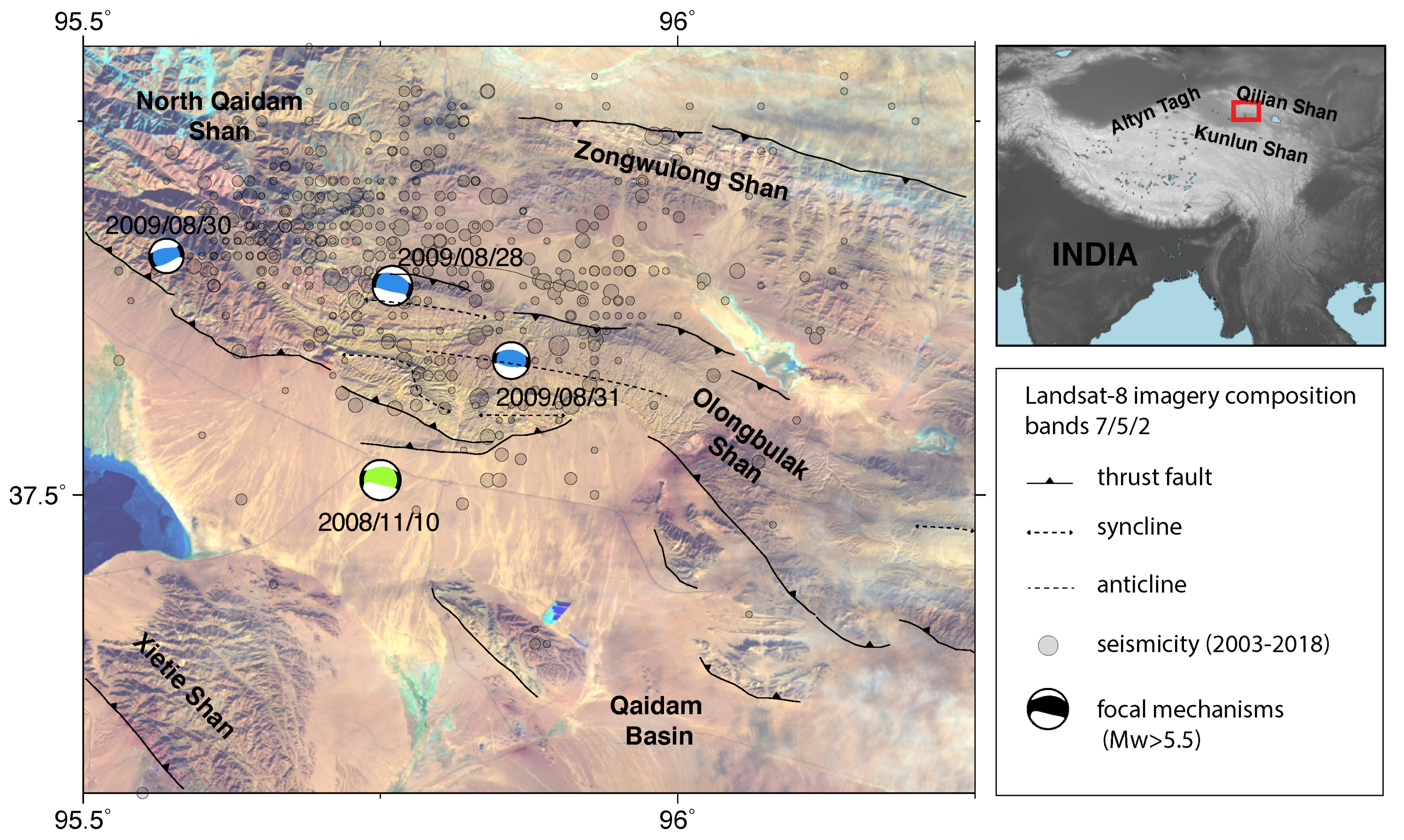
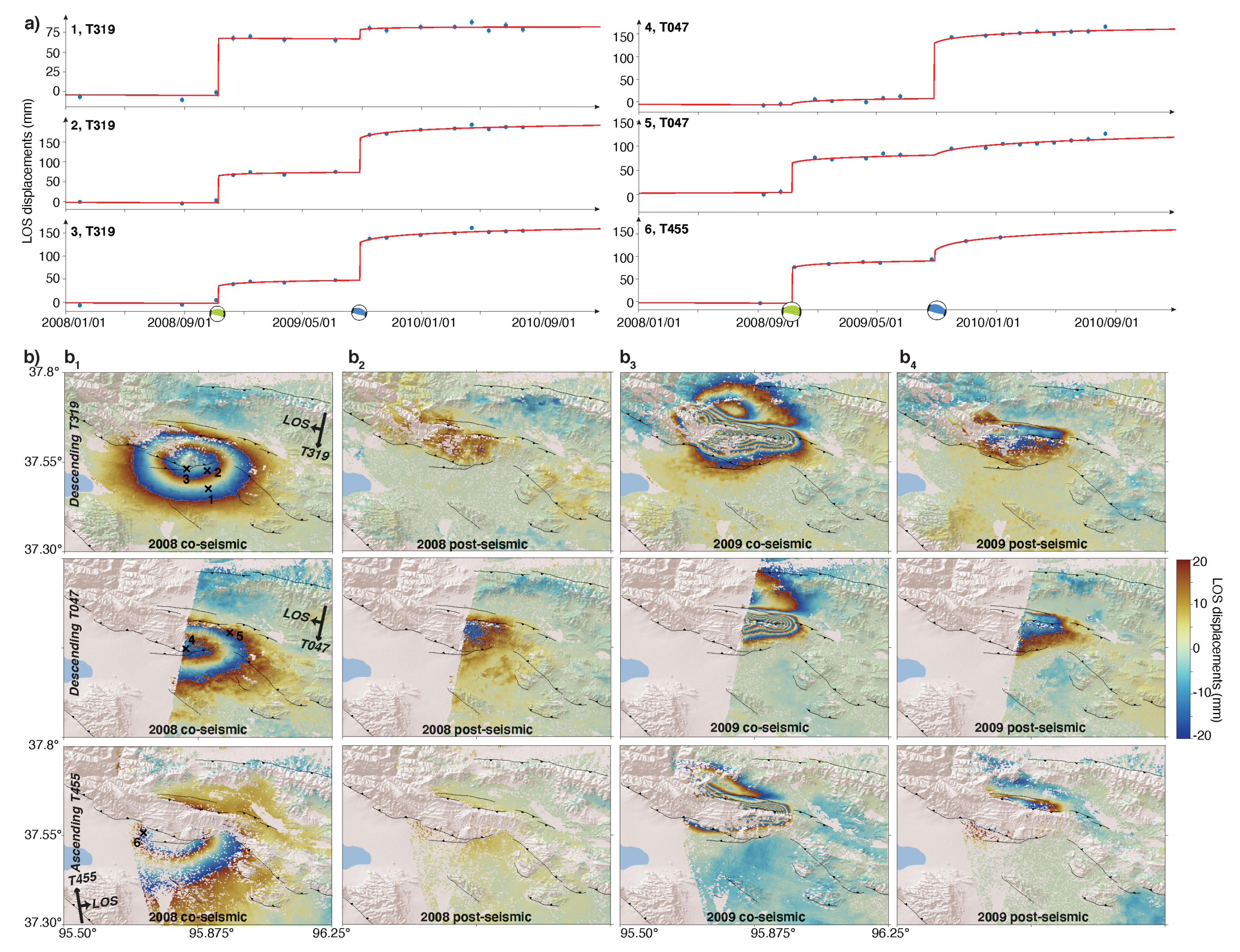
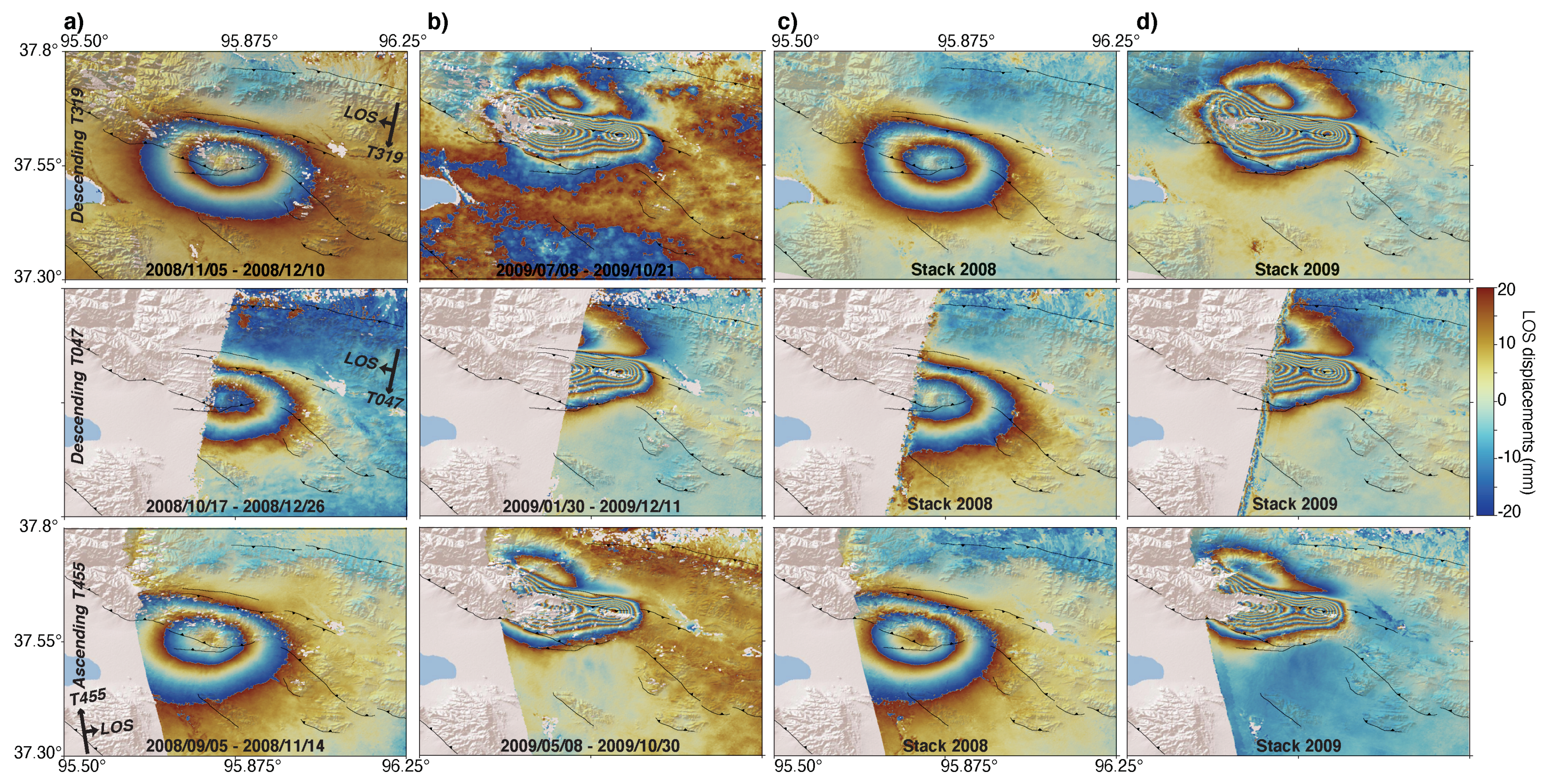
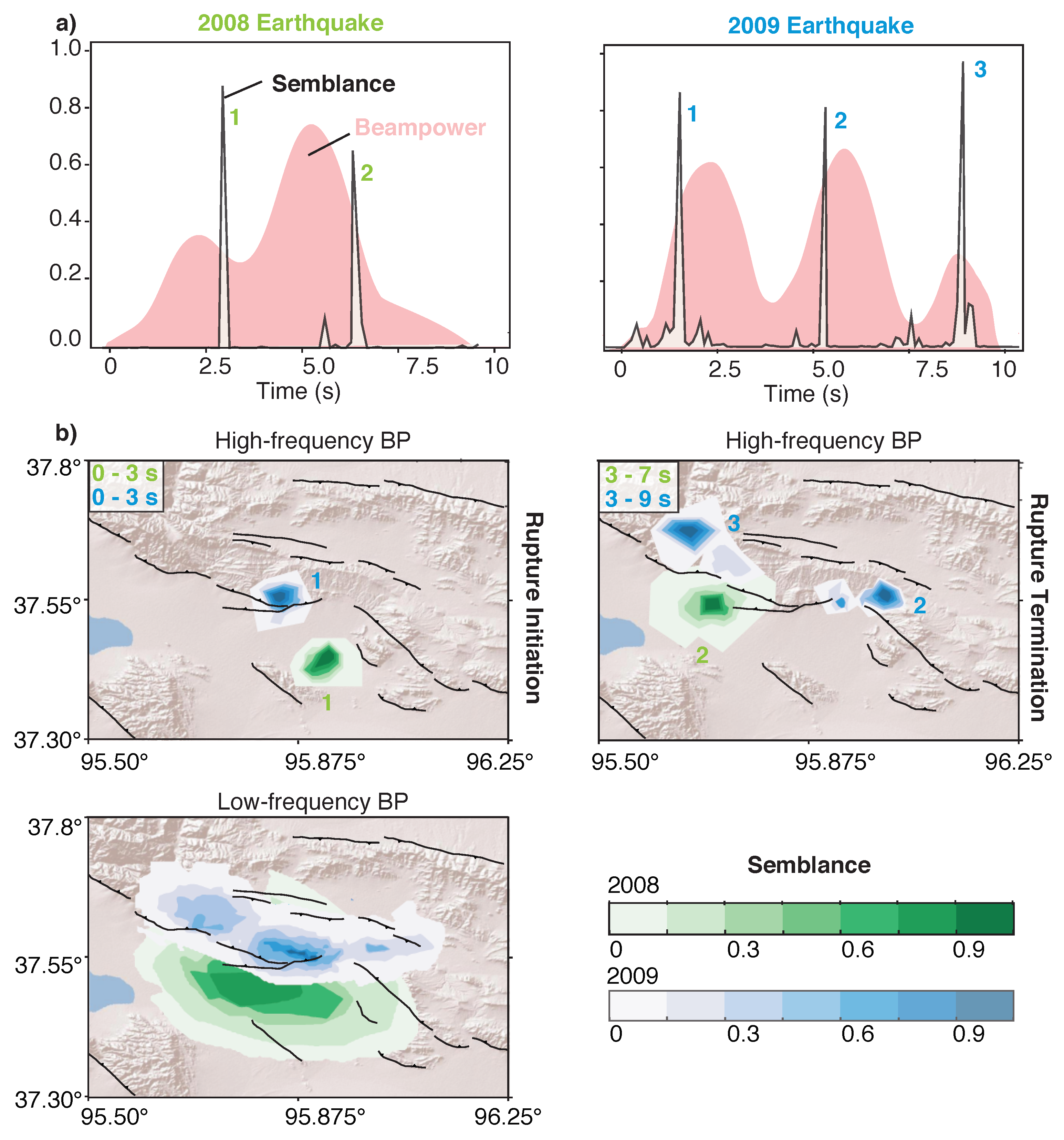
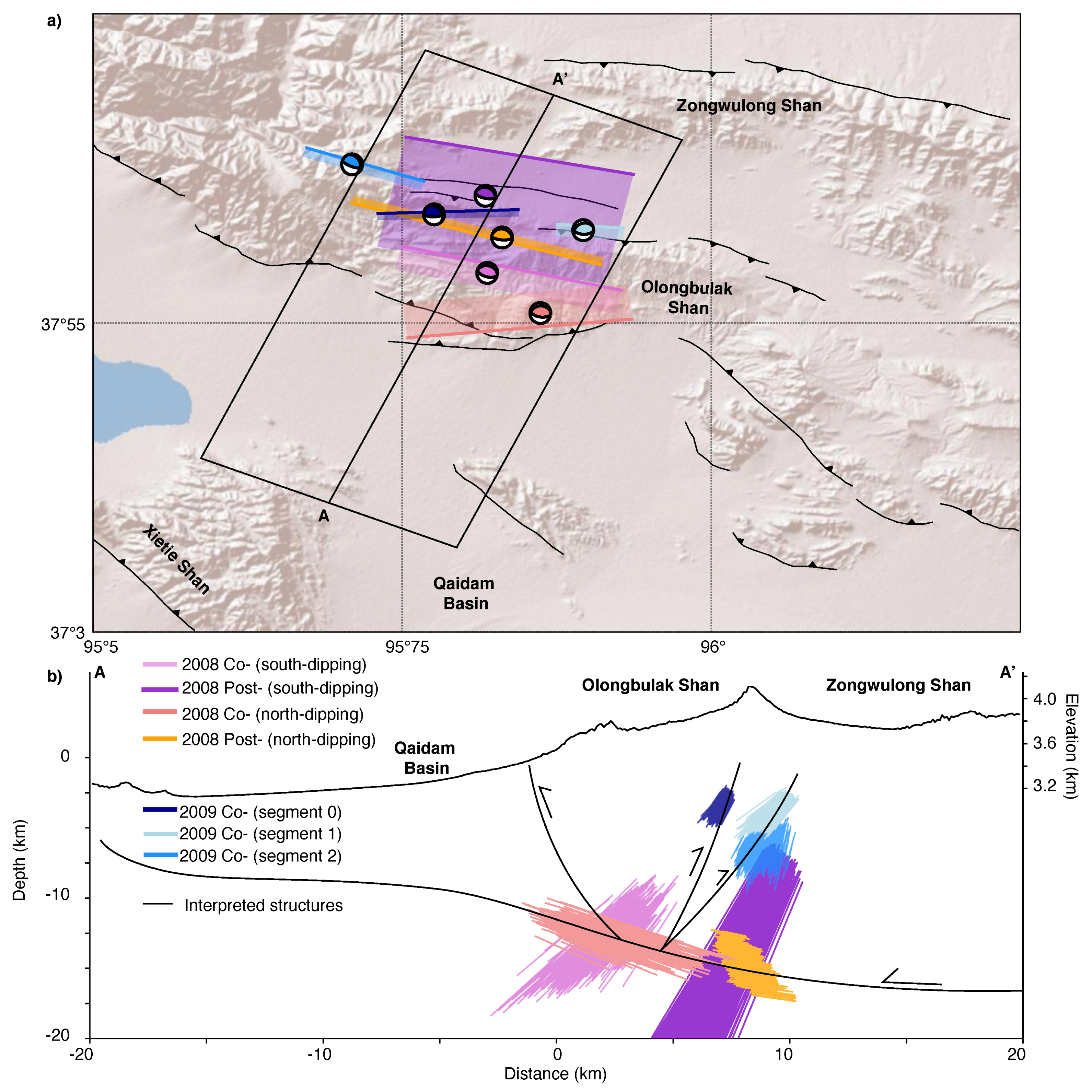
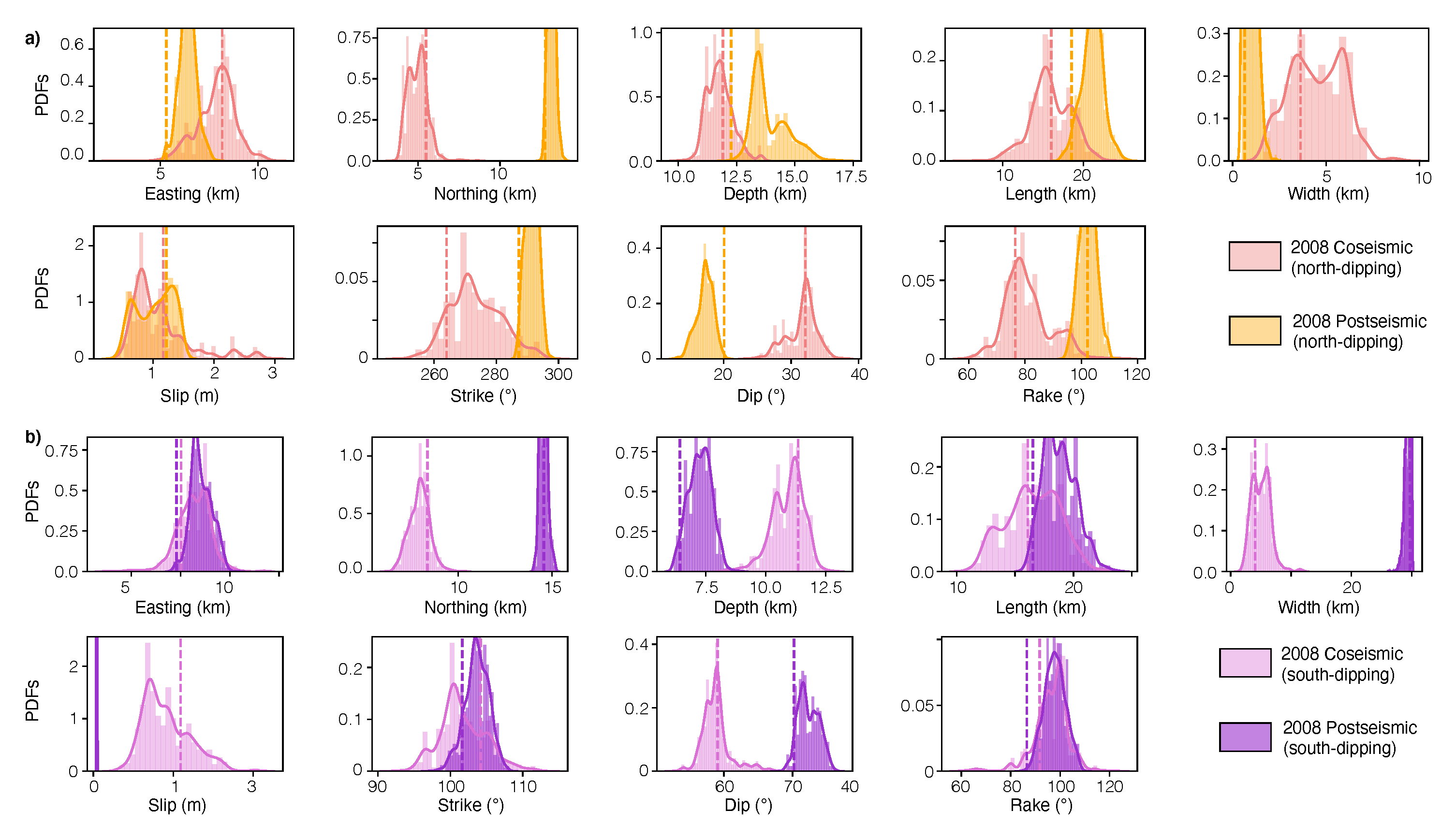

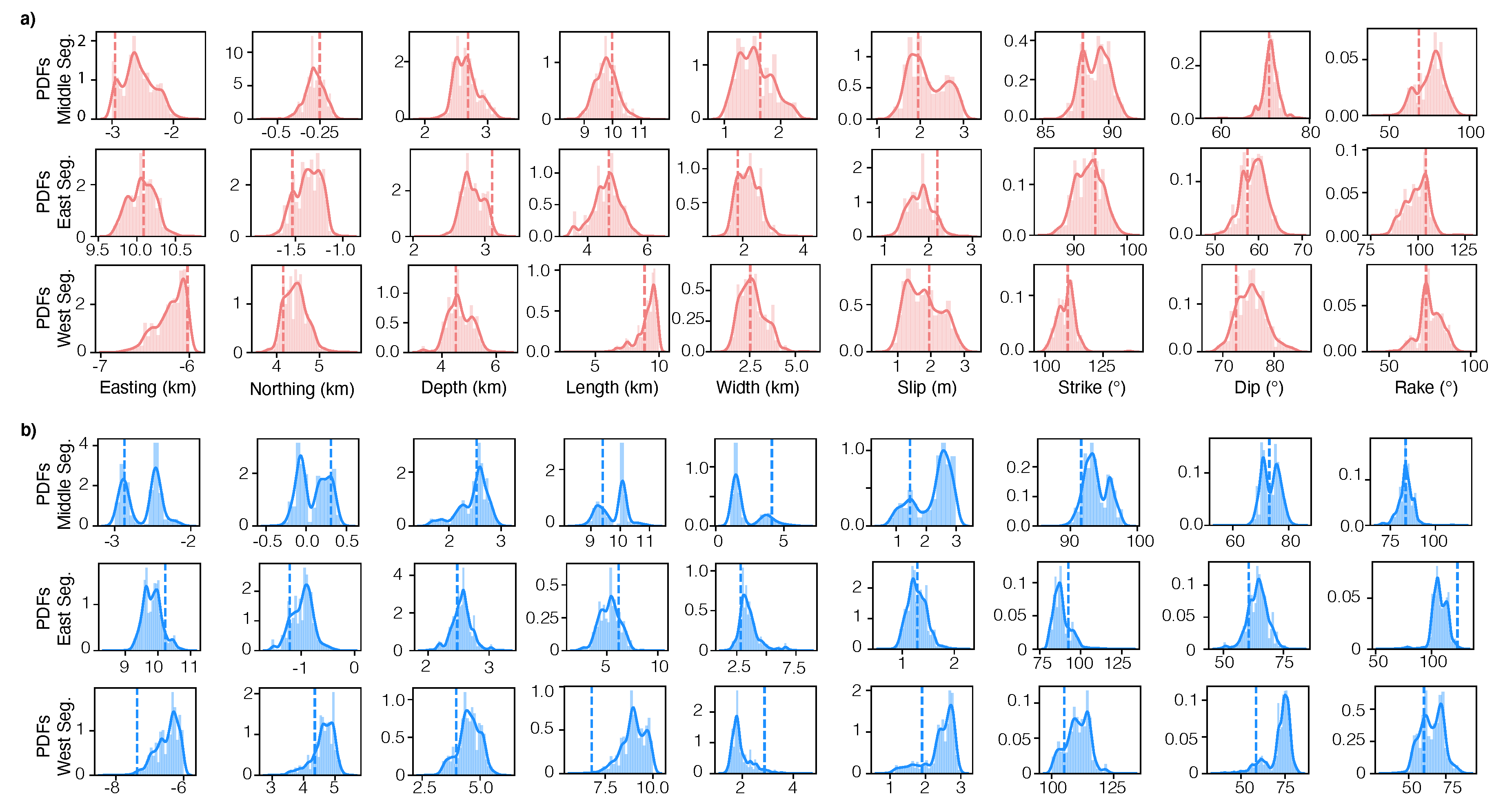

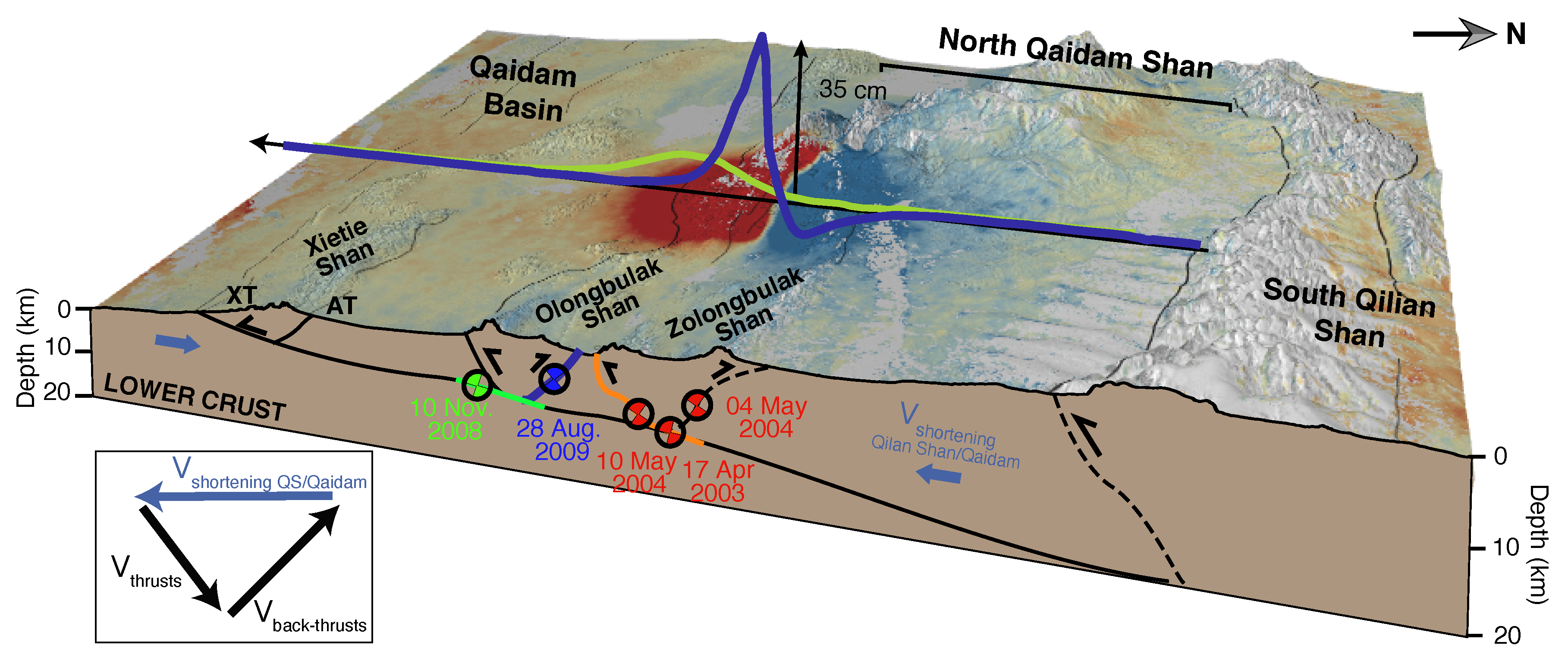
© 2020 by the authors. Licensee MDPI, Basel, Switzerland. This article is an open access article distributed under the terms and conditions of the Creative Commons Attribution (CC BY) license (http://creativecommons.org/licenses/by/4.0/).
Share and Cite
Daout, S.; Steinberg, A.; Isken, M.P.; Heimann, S.; Sudhaus, H. Illuminating the Spatio-Temporal Evolution of the 2008–2009 Qaidam Earthquake Sequence with the Joint Use of Insar Time Series and Teleseismic Data. Remote Sens. 2020, 12, 2850. https://doi.org/10.3390/rs12172850
Daout S, Steinberg A, Isken MP, Heimann S, Sudhaus H. Illuminating the Spatio-Temporal Evolution of the 2008–2009 Qaidam Earthquake Sequence with the Joint Use of Insar Time Series and Teleseismic Data. Remote Sensing. 2020; 12(17):2850. https://doi.org/10.3390/rs12172850
Chicago/Turabian StyleDaout, Simon, Andreas Steinberg, Marius Paul Isken, Sebastian Heimann, and Henriette Sudhaus. 2020. "Illuminating the Spatio-Temporal Evolution of the 2008–2009 Qaidam Earthquake Sequence with the Joint Use of Insar Time Series and Teleseismic Data" Remote Sensing 12, no. 17: 2850. https://doi.org/10.3390/rs12172850
APA StyleDaout, S., Steinberg, A., Isken, M. P., Heimann, S., & Sudhaus, H. (2020). Illuminating the Spatio-Temporal Evolution of the 2008–2009 Qaidam Earthquake Sequence with the Joint Use of Insar Time Series and Teleseismic Data. Remote Sensing, 12(17), 2850. https://doi.org/10.3390/rs12172850




